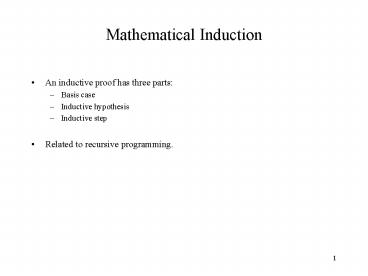Mathematical Induction - PowerPoint PPT Presentation
Title:
Mathematical Induction
Description:
Mathematical Induction An inductive proof has three parts: Basis case Inductive hypothesis Inductive step Related to recursive programming. Theorem: For all ... – PowerPoint PPT presentation
Number of Views:158
Avg rating:3.0/5.0
Title: Mathematical Induction
1
Mathematical Induction
- An inductive proof has three parts
- Basis case
- Inductive hypothesis
- Inductive step
- Related to recursive programming.
2
- Theorem
- For all ngt1.
- Proof 1 (by induction on n)
- Basis
- n 1
- 1 1
3
- Inductive hypothesis
- Suppose that for
some kgt1. - Inductive step
- We will show that
- by the inductive hypothesis
- It follows that
for all ngt1.
4
- Theorem
- For all ngt1.
- Proof 2 (by induction on n)
- Basis
- n 1
- 1 1
5
- Inductive hypothesis
- Suppose there exists a kgt1 such that that
for all m, where 1 lt m
lt k. - Inductive step
- We will show that
- by the inductive hypothesis
- It follows that
for all ngt1.
6
- What is the difference between proof 1 and proof
2? - The inductive hypothesis for proof 2 assumes
more than that for proof 1. - Proof 1 is sometimes called weak induction
- Proof 2 is sometimes called strong induction
- Many times weak induction is sufficient, but
other times strong induction is more convenient.
7
Strict Binary Trees
- Definition 1
- Let T(V,E) be a tree with Vgt1. Then T is a
strict binary tree if and only if each vertex in
T is either a leaf or has exactly two children. - Definition 2 (recursive)
- A single vertex is a strict binary tree.
- Let T1(V1,E1) and T2(V2,E2) be strict binary
trees with roots r1 and r2, respectively, where
V1 and V2 do not intersect. In addition, let r be
a new vertex that is not in V1 or V2. Finally,
let - Then T3(V3,E3) is a strict binary tree.
- Nothing else is a strict binary tree.
8
- Theorem
- Let L(T) denote the number of leaves in a strict
binary tree T(V,E). Then - 2L(T) 2 E
- Proof (by induction on L(T))
- Basis
- L(T) 1
- Observation The only strict binary tree with
L(T) 1 has a single vertex and 0 edges, i.e.,
E 0. - Lets evaluate 2L(T)-2 and see if we can show
it is equal to E. - 2L(T) 2 2 1 2 Since L(T) 1
- 0 E Since the
observation tell us that E 0
9
- Inductive hypothesis
- Suppose there exists a kgt1 such that for every
strict binary tree where 1ltL(T)ltk that 2L(T)
2 E. - Inductive step
- Let T(V,E) be a strict binary tree where
L(T)k1. We must show that 2L(T) 2 E. - Notes about T
- Since kgt1 and L(T)k1, it follows that L(T)gt1.
Therefore T consists of a root r and two strict
binary trees T1(V1,E1) and T2(V2,E2), where
1ltL(T1)ltk and 1ltL(T2)ltk. - L(T) L(T1) L(T2) by definition of T
- E E1 E2 2 also by definition of T
- Lets start with 2L(T) - 2 and, using 1-3, see
if we can show that it is equal to E.
10
- 2 L(T) 2 2 (L(T1) L(T2)) 2 by (2)
- 2 L(T1) 2 L(T2) 2
- (2 L(T1) 2) (2 L(T2) 2) 2
- Since 1ltL(T1)ltk and 1ltL(T2)ltk from (1), it
follows from the inductive hypothesis that - 2 L(T1) 2 E1 and
- 2 L(T2) 2 E2
- Substituting these in the preceding equation
gives - E1 E2 2
- E by (3)
- Hence, for all strict binary trees, 2 L(T) 2
E. - Finally, note the use of strong induction in the
above proof.































